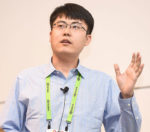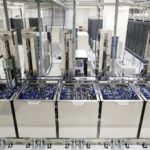In this special guest feature from the SC19 Blog, Charity Plata from Brookhaven National Lab catches up with Dr. Lin Gan from Tsinghua University, who’s outstanding work in HPC has been recognized with a number of awards including the Gordon Bell Prize. As a highly awarded young researcher who already has been acknowledged for “outstanding, influential, and potentially long-lasting contributions” in HPC, Gan shares his thoughts on future supercomputers and what it means to say, “HPC Is Now.”
Gordon Bell Prize Highlights the Impact of Ai
In this special guest feature from Scientific Computing World, Robert Roe reports on the Gordon Bell Prize finalists for 2018. “The finalist’s research ranges from AI to mixed precision workloads, with some taking advantage of the Tensor Cores available in the latest generation of Nvidia GPUs. This highlights the impact of AI and GPU technologies, which are opening up not only new applications to HPC users but also the opportunity to accelerate mixed precision workloads on large scale HPC systems.”
Lessons on Integrating and Utilizing 10 Million Cores: Experience of Sunway TaihuLight
Haohuan Fu gave this Invited Talk at SC17 in Denver. “The Sunway TaihuLight supercomputer is the world’s first system with a peak performance greater than 100 PFlops and a parallel scale of over 10 million cores. Different from other existing heterogeneous supercomputers, the system adopts its unique design strategies in both the architecture of its 260-core Shenwei CPU and its way of integrating 40,960 such CPUs as 40 powerful cabinets. This talk will first introduce and discuss design philosophy about the approach to integrate these 10 million cores, at both the processor and the system level.”
China to Develop Exascale Prototype in 2017
The Xinhua news agency reports that China is planning to develop a prototype exascale supercomputer by the end of 2017. “A complete computing system of the exascale supercomputer and its applications can only be expected in 2020, and will be 200 times more powerful than the country’s first petaflop computer Tianhe-1, recognized as the world’s fastest in 2010,” said Zhang Ting, application engineer with the Tianjin-based National Supercomputer Center, when attending the sixth session of the 16th Tianjin Municipal People’s Congress Tuesday.
Riken’s Shoubu Supercomputer Leads Green500 List
Today the Green500 released their listing of the world’s most energy efficient supercomputers. “Japan’s research institution RIKEN once again captured the top spot with its Shoubu supercomputer. With rating of 6673.84 MFLOPS/Watt, Shoubu edged out another RIKEN system, Satsuki, the number 2 system that delivered 6195.22 MFLOPS/Watt. Both are “ZettaScaler”supercomputers, employing Intel Xeon processors and PEZY-SCnp manycore accelerators.
93 Petaflop Chinese Supercomputer is World’s Fastest on Latest TOP500 List
A new machine called Sunway TaihuLight in China is the fastest supercomputer on the planet. Announced today with the release of the latest TOP500 list, the 93 Petaflop machine sports over 10.6 Million compute cores. “The latest list marks the first time since the inception of the TOP500 that the U.S is not home to the largest number of systems. With a surge in industrial and research installations registered over the last few years, China leads with 167 systems and the U.S. is second with 165. China also leads the performance category, thanks to the No. 1 and No. 2 systems.”









